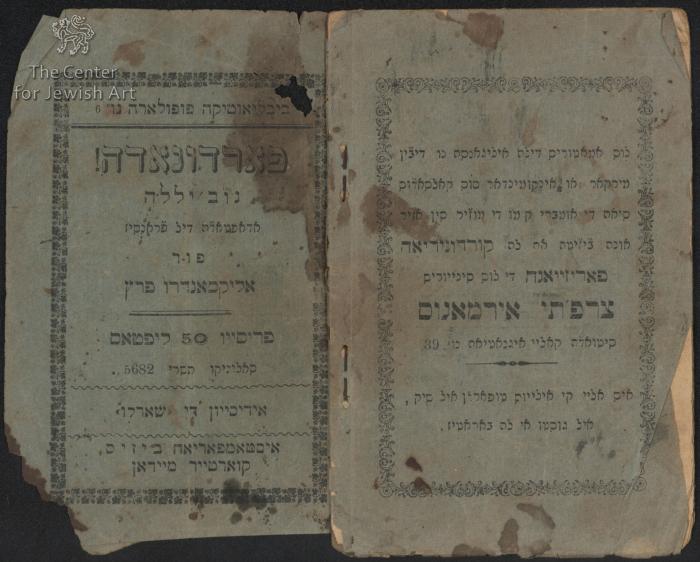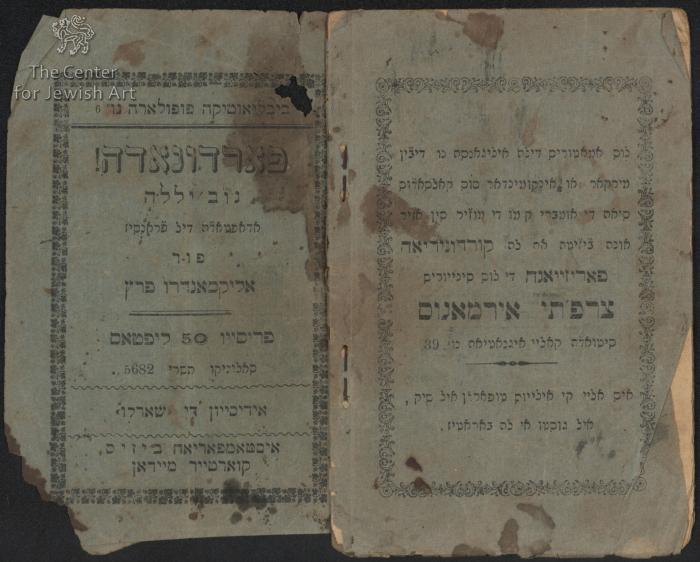Obj. ID: 39652 Pardonada: Novella, Thessaloniki (Salonika), 1921

© Gross Family Collection, Photographer: Unknown,
sub-set tree:
Name/Title
Pardonada: Novella (in Ladino) | Unknown
Object
Object Detail
Date
1921
Synagogue active dates
Reconstruction dates
Artist/ Maker
Unknown (Unknown)
Origin
Historical Origin
Unknown
Community
Unknown |
Location
Unknown |
Site
Unknown
School/Style
Unknown|
Period
Period Detail
Gross Family Collection No.
B.2286
Category
Material/Technique
Paper, Ink,
Material Stucture
Material Decoration
Material Bonding
Material Inscription
Material Additions
Material Cloth
Material Lining
Tesserae Arrangement
Density
Colors
Construction material
Measurements
Height
16 cm
Length
Width
10.7 cm
Depth
0.2 cm
Circumference
Thickness
Diameter
Weight
Axis
Panel Measurements
Hallmark
Iconographical Subject
Unknown |
Condition
Extant
Documented by CJA
Surveyed by CJA
Present Usage
Present Usage Details
Condition of Building Fabric
Architectural Significance type
Historical significance: Event/Period
Historical significance: Collective Memory/Folklore
Historical significance: Person
Architectural Significance: Style
Architectural Significance: Artistic Decoration
Urban significance
Significance Rating
Description
Custom
Contents
Codicology
Scribes
Script
Number of Lines
Ruling
Pricking
Quires
Catchwords
Hebrew Numeration
Blank Leaves
Direction/Location
Façade (main)
Endivances
Location of Torah Ark
Location of Apse
Location of Niche
Location of Reader's Desk
Location of Platform
Temp: Architecture Axis
Arrangement of Seats
Location of Women's Section
Direction Prayer
Direction Toward Jerusalem
Signature
Colophon
Scribal Notes
Watermark
Binding
Decoration Program
Summary and Remarks
History/Provenance
The history of Hebrew printing in Salonica began in the early 16th and lasted some 400 years, being brought to an end only with the Nazi conquest. The first Hebrew press was established in Salonica in 1512 by a Portuguese printer and émigré, Ibn Gedalya. By the 1560s, with the mass influx of former Marranos from the Iberian Peninsula, the printing activity in Salonica flourished. The 18th-19th centuries witnessed another flourishing, with the establishment of printing houses that lasted for significant periods of time. In the 20th century, new printing houses were founded which handled all types of printing work, including books and popular literature in Ladino.
Main Surveys & Excavations
Bibliography
Short Name
Full Name
Volume
Page
Type
Documenter
|
Researcher
William Gross |
Architectural Drawings
|
Computer Reconsdivuction
|
Section Head
|
Language Editor
|
Donor
|
Object Copyright
Gross Family Collection (GFC)







